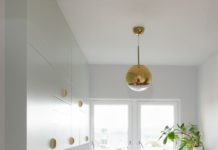Replacing fluorescent tubes against LEDs - Tips on choosing the right LED tube

If you replace an old fluorescent tube with LED, you can take advantage of the many advantages of LED lighting. In addition to saving energy and cleaning for your money bag, LEDs have a significantly longer life and better light quality. If you should pay attention to LED tube lighting, which LED tubes are available and where the difference is between T5 and T8 LED tubes - all of them are experienced by our advisers.
Replace fluorescent tubes against LED - What color temperature?

When exchanging a fluorescent tube with LED, it is important that you adjust the brightness and light color of the LED tube and your needs. The color temperature of LED lights is indicated on a scale with the name Kelvin (K). The common spectrum usually ranges from 2400 to 6500 Kelvin. A lower Kelvin value means that light is perceived as "warm". Cold white or neutral white usually refers to lamps with a color temperature of approx. 4000 K. This color temperature is recommended for conference rooms, supply rooms, work areas and offices. Daylight white corresponds to a color temperature of over 5000 Kelvin. The daylight fluorescent tubes are best suited for high-security areas, garages, park systems and exhibit areas. At the market for luminaires, you will find all the important light colors to achieve the appropriate light mood for every environment.
So choose the right LED tube

LED tubes are available in so many variants that you can easily lose the overview. The choice of the right LED tube is done in just three steps:
- Choose the correct length (maximum 120 or 150 cm).
- Choose the right diameter.
- Determine if you need a fluorescent lamp with EVG (electronic) or KVG (conventional) prescriber.

Pipe length and pin size
To determine if you need a T8 or T5 LED tube lamp, remove the old fluorescent tube and measure either the diameter of the tube or the spacing between the pins. Most LED tubes in modern buildings are compatible with T8 pins. Newer or recently finished buildings still have the possibility of the more modern T5 lights.
T5 fluorescent tubes have a diameter of 16 mm and the G5 socket. The connector pins at each end of a T5 fluorescent tube are removed 5 mm from each other.
T8 fluorescent tubes have a diameter of 27.5 mm and the G13 socket. The connecting pins at each end of a T8 fluorescent tube show a distance of 13 mm.
If T8 and T12 are fitted over the same base (most frequently G13), you can use both, as long as you have tested the current requirements for the preset device (if applicable).

What LED tubes are there?
Basically, there are two main variants of fluorescent tubes:
- Type 1: Fluorescent tube with conventional preset KVG (with starter)
If you recognize Type1 with a starter, it means that you need a LED fluorescent tube for KVG. For lights with KVG, dummy starters (bridging elements) were delivered during the purchase. These tubes are extremely easy to install and are also called plug-and-play. - Type 2: Fluorescent tube with electronic pre-switch device EVG (without starter)
If you are not able to see a starter in your fluorescent tube, it deals with a high degree of safety on an electronic device. In this case, you need an EVG compatible LED fluorescent tube.
The 4 main reasons why you should replace fluorescent tubes with LEDs

Save power - LED tube lights are on average 30% more efficient than fluorescent tubes. 2 Fluorescent tubes are replaced by 1 T8 LED tube. The larger the number of exchanged neon tubes, the higher the current savings can be.
Longer service life - LED tubes last more than 50,000 hours. By comparison, the lifetime of the fluorescent tubes lies at 30,000 hours. Besides, LEDs differ from fluorescent tubes, in that they do not flicker.
Better Light in better quality - LED tubes are not quite as bright as fluorescent tubes, but also have a substantially higher color reproduction (CRI), which allows for the best possible daylight detection. Since these LEDs are available in multiple light spectrums (from cold to warm), let different light moods be realized.
Mercury-free, not breakable - In contrast to fluorescent lamps, LED tubes contain no toxic mercury. Besides, LED tubes are very robust and do not break like fluorescent tubes.
The post fluorescent tube to replace LED - Tips for choosing the right LED tube appeared first on Deavita.com | Home ideas, design, hairstyles, makeup, lifestyle, health and beauty tips.





















